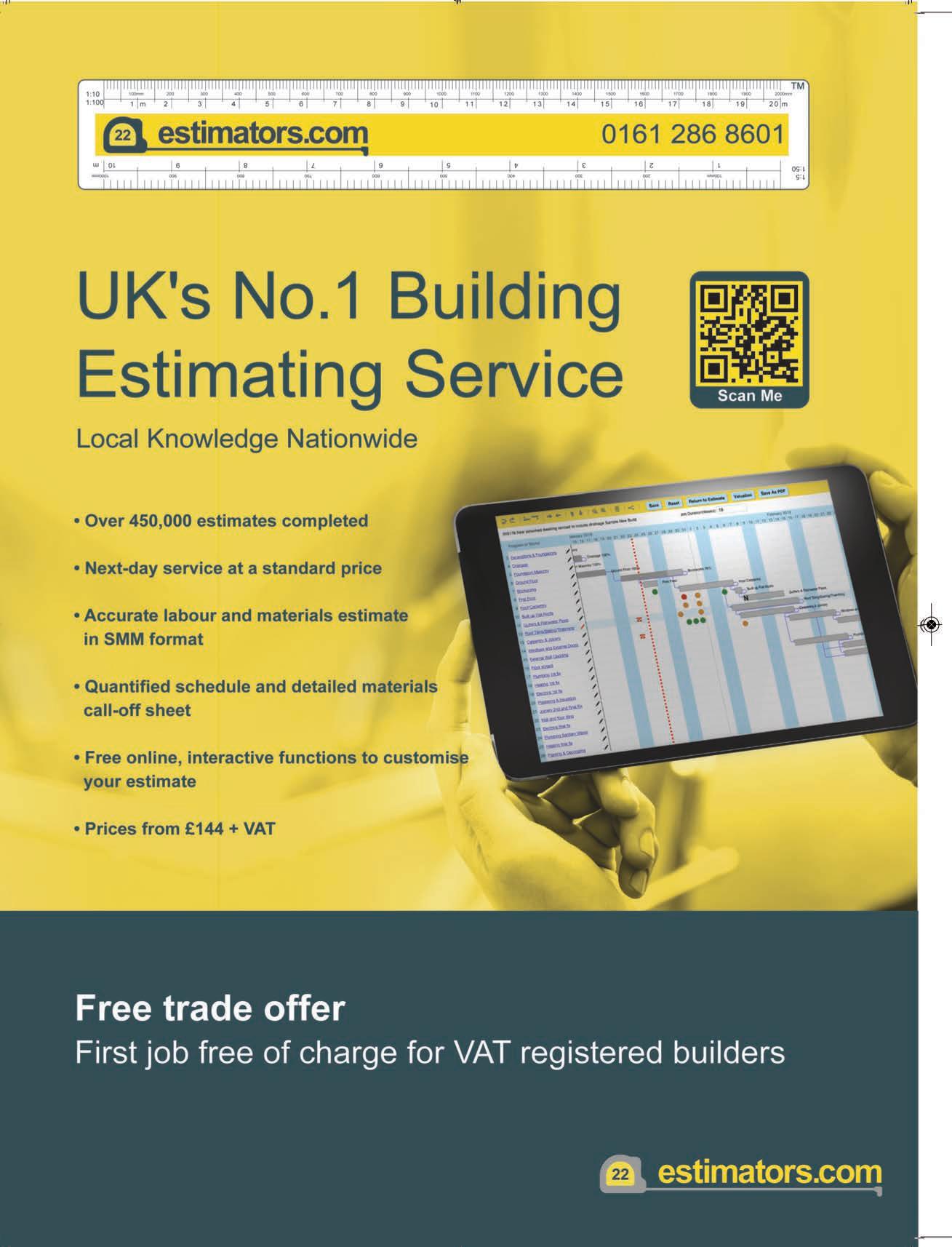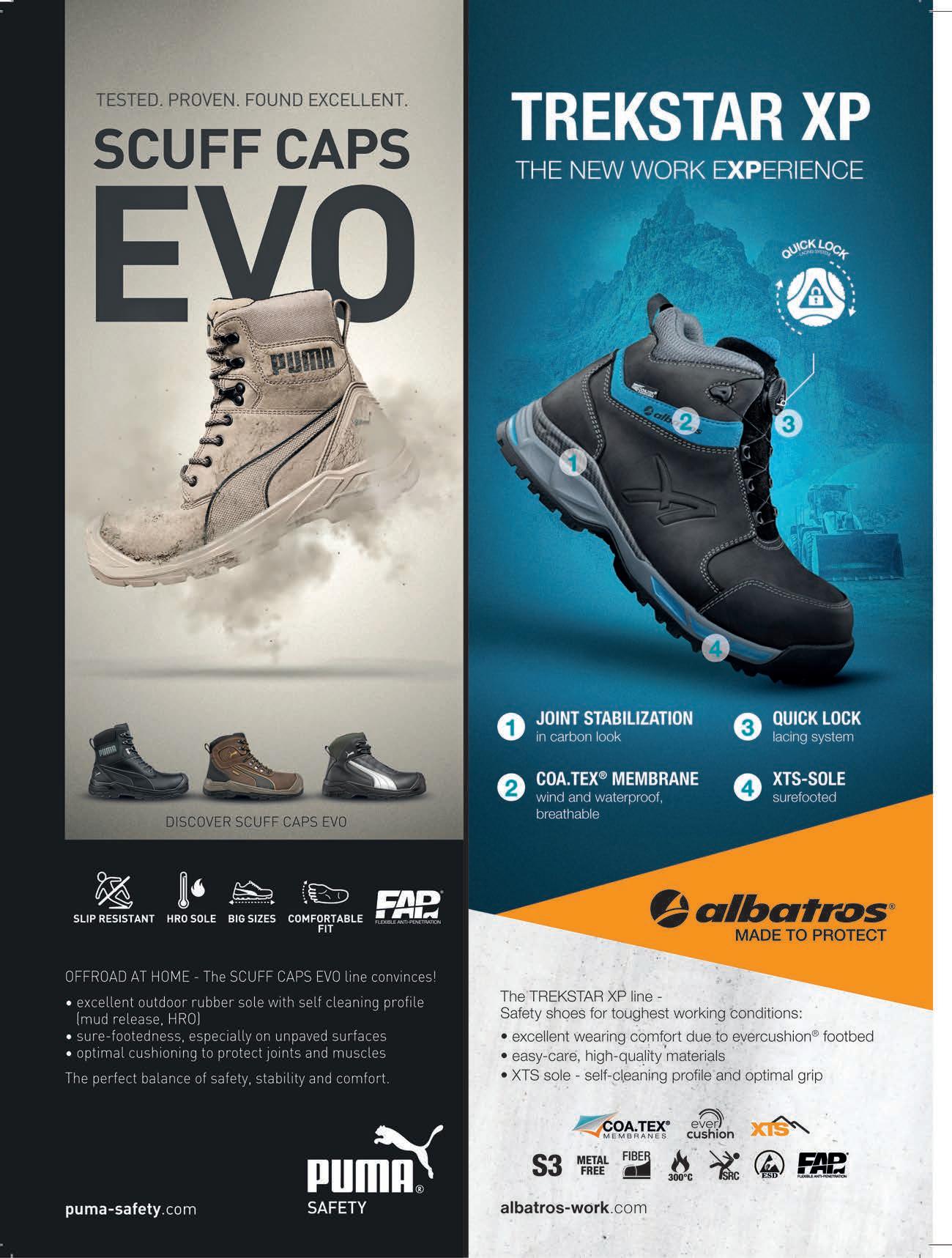
70 minute read
48Festool – CSC SYS
Quality time
Brinley Buckley-Roberts, Brand Manager at Carl Kammerling International, the home of C.K Tools, discusses why premium hand tools are worth more than ever
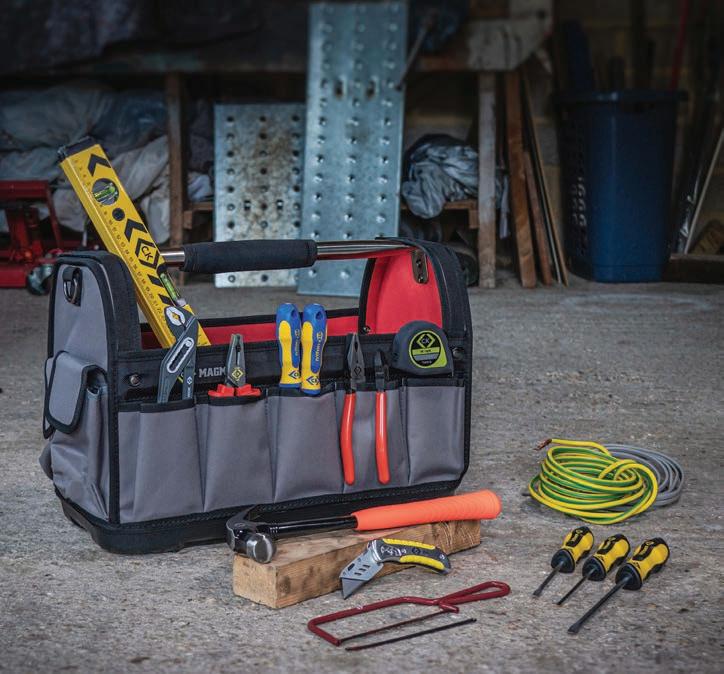
Many of us will struggle to remember a time when we tracked our spending as closely. Price hikes are diminishing profits and each and every purchase is being made with extreme caution and forward planning. The costof-living crisis has altered the way we think about expenditure in both our personal and professional lives.
While cost cutting may have become a necessity, the old adage ‘buy cheap, buy twice’, has never been truer. Tool choice always requires careful consideration. For any builder, an inadequate tool can lead to downtime, a slow work rate, and ultimately an un-forecasted replacement purchase, all impacting bottom lines. A tool that delivers a poor finish can lead to reputational damage and kill repeat business. At their worst, poor tools can be unsafe.
Perhaps now more than ever is the time to invest in premium tools. In challenging times, it makes sense to be fully equipped to deliver speedy, top-quality results, safely, and without the threat of unexpected expenditure. Investing in premium hand tools can really make a difference in both the short and long-term.
Purchasing decisions
So, what should you look for when purchasing tools? There are several elements to consider, and a few key areas that separate premium tools from the rest: the R&D process; the source of the materials; the engineering and manufacturing procedures; the quality control and accreditation. Each element undergoes a constant review as new materials, manufacturing techniques, or industry requirements are uncovered, with the effectiveness, durability and safety of the products always top of mind.
Research and development can mean many things but for C.K Tools this means listening intently to what the industry is asking for. We utilise a panel of professionals to not only find solutions to problems, but to also find the existing product evolutions that will make the job that much more efficient. From there, our NPD team goes into design and considers the aesthetics, the ergonomics, and of course the materials. There’s no product without a clear rationale; each one is meticulously planned, refined, prototyped and tested.
Material choice is of great importance to C.K Tools and has contributed considerably to the reputation we’ve built

over more than 200 years. In the most part we procure our steel from, and manufacture our products in, Germany, in particular the North Rhine, which is worldrenowned for its steel production. The region’s steel has varying levels and mixes of chromium, which has excellent corrosion resistance, vanadium, which works as a deoxidiser and reduces wear, and molybdenum, which when combined with chromium gives greater strength and impact resistance.
Not content with its premium grade steel, the North Rhine is also known as the industrial heartland for tool manufacturing. The steel mills, chemical and water treatment businesses, and manufacturing plants all reside there and have developed great ways of collaborating over the years to ensure that the potential of the raw material is not lost through the processing and engineering stages.
C.K Tools has been working with its current manufacturing partners since 1904 and there’s a reason for it; in today’s market it is very rare that products are manufactured to the very peak of excellence but with German engineering practices that’s a given. Precision engineering requires a number of inputs and with hand tool manufacturing that starts with the quality of the die – the item used to stamp the shape of the tool in the steel. Utilising a mixture of CAD and CNC, dies can be cut to within a tolerance the equivalent of a human hair, delivering a near perfect product with every stamp.
Other engineering techniques are then used to ensure our products offer outstanding longevity. Induction hardening is a process we use to ensure that parts of products – such as the jaws on pliers – are hardened to withstand heavy usage and ensure long-term performance. It involves electromagnetically heating up the steel and then rapidly cooling it to maintain the desired properties.
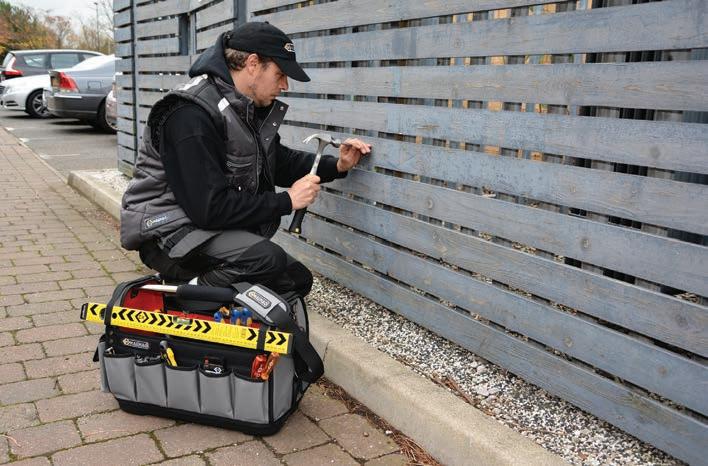
In safe hands
The precision engineering techniques don’t stop at the steel; hand tools must be inherently comfortable and safe to handle. To ensure this, every single screwdriver handle is injection moulded directly to the steel, giving the ultimate torsion-proof bond for increased reliability, durability, control and comfort. These touches all contribute to an easier and faster working experience –and profitable efficiency.
A premium product isn’t just premium because a brand says it is; when other bodies endorse a product you know it sits above the rest. Across certain lines, the products are VDE certified, which is the highest form of independent safety testing, while the majority achieve GS (Gepruefte Sicherheit) and DIN (Deutsche Institut) accreditation, which are German standards that indicate performance and quality.
Paying a premium price for a tool may seem counter-intuitive during a cost-ofliving crisis, but it’s important to understand what you’re paying for and how it will impact the work you produce. C.K Tools understands its customers; understands the requirements of each and every job; and is unwavering in its pursuit of precision engineering the perfect product to sell and to use. Yes, German engineered products come with a premium, but rest assured, they’ll be the best investments you’ll make.
FOR FURTHER INFORMATION ON C.K TOOLS, VISIT WWW.RDR.LINK/BAP053

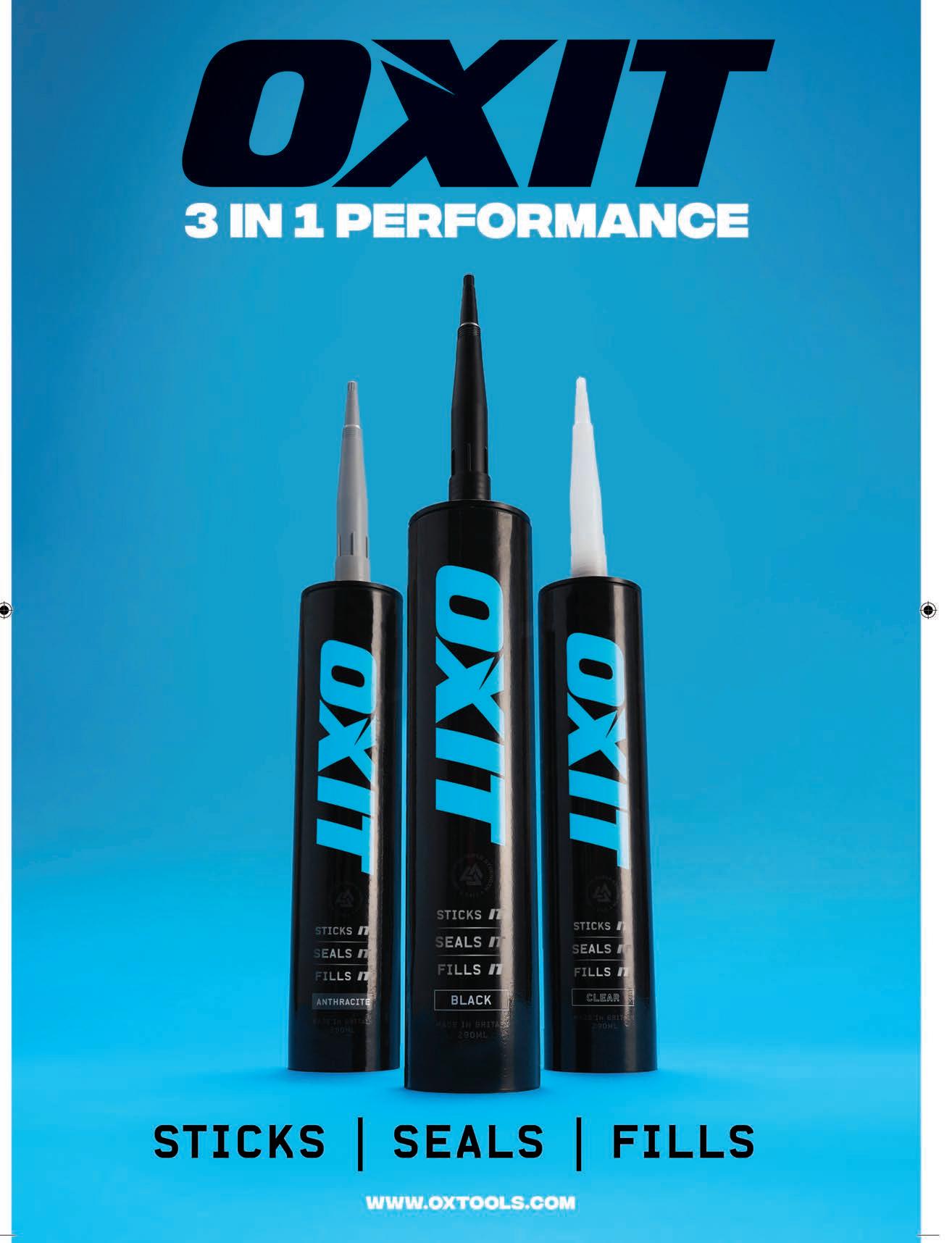

THE RIGHT COMBINATION
Kevin Brannigan, Marketing Manager at Makita, explains how the combination of a versatile, high performance drill-driver and specially engineered multi-purpose drillbits can help improve productivity.
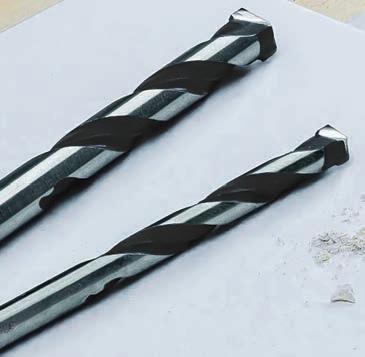
As most jobs include many different tasks and materials, it is essential to select power tools and accessories that are both versatile and durable. This helps professionals achieve maximum efficiency by eliminating the need to regularly change tools, bits and blades – a task which can cause delays and frustration.
As any professional will know, a combination or ‘Combi’ drill is a useful tool to have in your kit for a variety of tasks. However, it is important to select one with the right features and performance. For example, the Makita DHP486 18V LXT Brushless Combi Drill is a highly versatile cordless tool that can be used in three modes: drilling (rotation only), hammer drilling (rotation with percussion) and screwdriving. When operated in drilling mode, it has a capacity of 13mm in steel, 16mm in masonry and 76mm in wood. Additionally, it delivers up to 31,500 blows per minute (BPM) in the hammer drill setting. In driver mode, the tool’s variable speed trigger and 21 torque settings means it is easy to finely adjust the output for the task at hand.
When selecting a new tool, it is also beneficial to look for one that features a brushless motor, such as the DHP486, to help ensure performance and productivity. The high-efficiency brushless motor eliminates friction within the mechanism allowing it to produce more torque per weight and requiring less power to achieve the same result. This extends run times by between 30% and 50% on each battery charge.
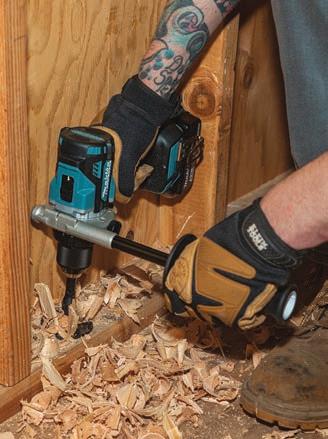
Multi-tasking
Another way to increase productivity is to select multi-purpose drill bits. Typically, drill bits are designed for use with a specific material and as a result, they need to be swapped out regularly. This can be a particular challenge when a job requires work with several different materials. For example, window fitting where the frames are uPVC and metal and fixed to brickwork, making standard drill bits susceptible to wear and tear. When time is at a premium, this can become an additional burden, leading some to use one bit for different tasks in an attempt to speed up the process. However, this can cause damage to both the drill bit and the material being worked on, causing additional costs and wasted time.
Therefore, it is important to select products that have been engineered for wear and impact resistance and are suitable for multi-layered materials. For example, the Makita OmniBohrer range has been specifically designed for use on a range of materials commonly found on site, including concrete, tile, brick, slate, limestone, wood, composite materials, plastics, aluminium and other metals, therefore eliminating the need to switch bits for each.
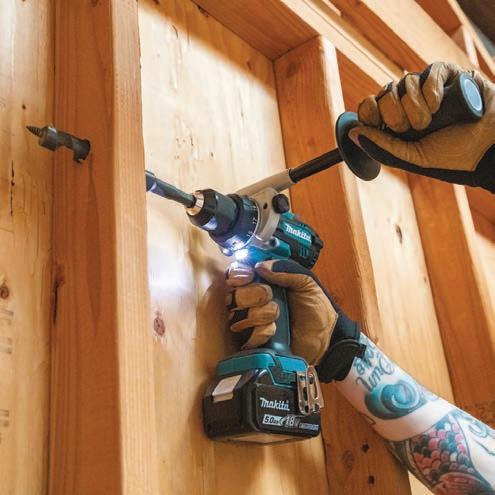
6TH IN THE SERIES
Durability
These high-performance, multi-purpose drill bits feature high-quality tungsten carbide tips (TCT) engineered with wider flutes to deliver quick and efficient material extraction. Tungsten carbide is an extremely hard compound widely known for its superior durability and high melting point, and the OmniBohrer TCT tip has been specially designed to drill into brick without the need to use percussion or hammer drilling mode. Additionally, OmniBohrer drill bits can be used in rotary mode to drill through wood, metal and brickwork, so they are ideal for use with drill-drivers without any hammer action, or with Combi Drills using only the rotary drilling setting.
Given the number of different tasks that any one job may include, it is clear that investing in high-quality combi drills and versatile multi-purpose drill bits can help to improve productivity and reduce the risk of damage to materials, saving both time and money.
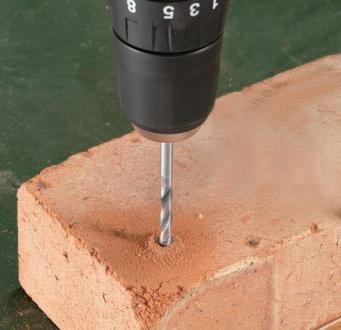
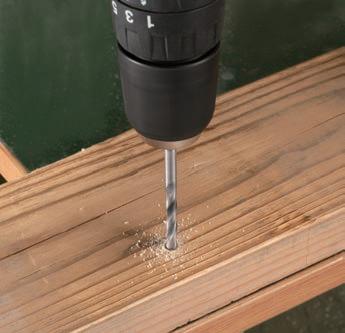
TO FIND OUT MORE ABOUT MAKITA’S RANGE OF HIGH-QUALITY POWER TOOLS AND ACCESSORIES, VISIT: WWW.RDR.LINK/BAP054

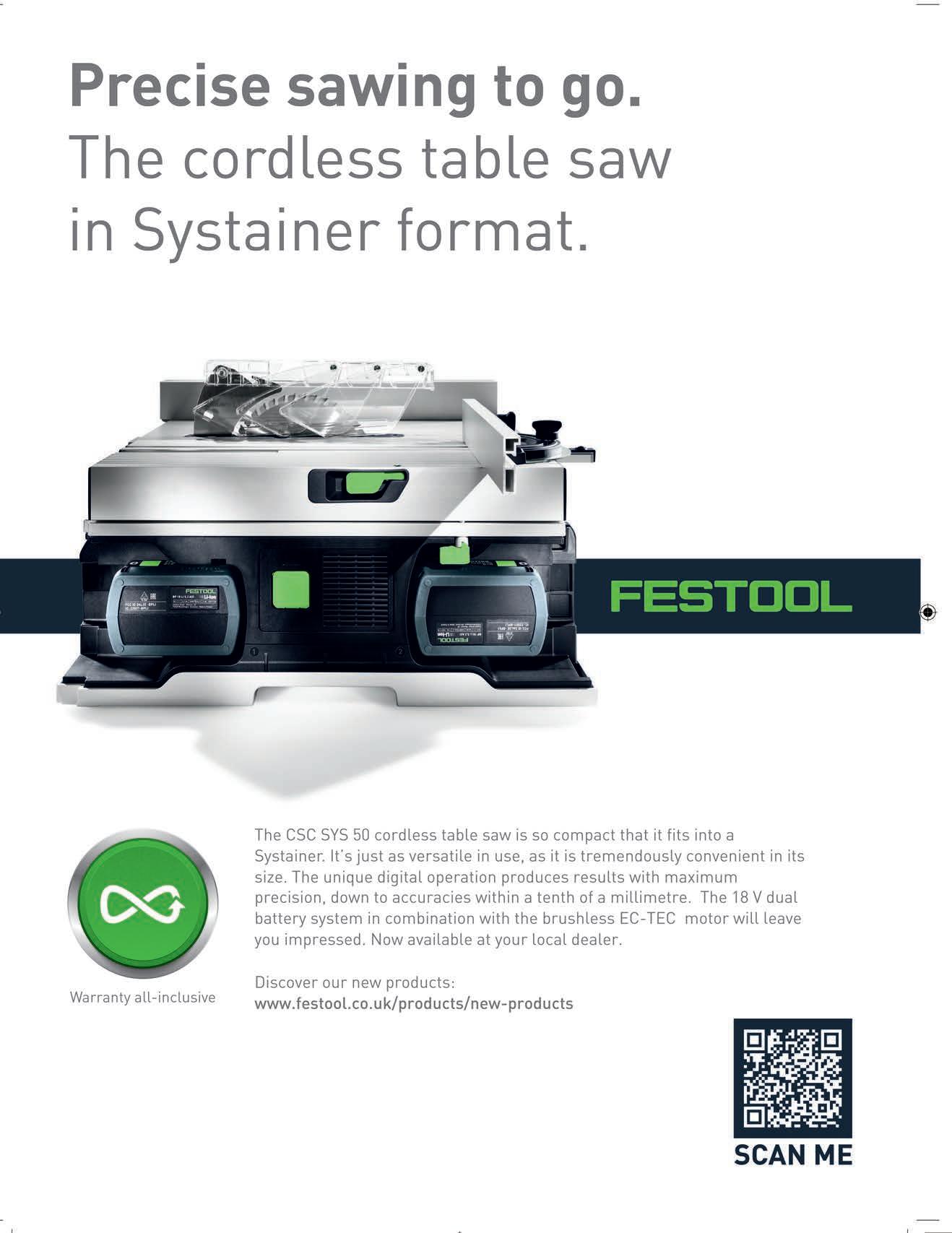
Custom dictates
Workwear of the future is how Mascot is describing its new Customized collection
Tradespeople now and in the future demand workwear that is as light and comfortable as sportswear, as durable as workwear, and preferably with the highest possible proportion of recycled materials.
Mascot Customized workwear is a range developed to be extremely long lasting and made from a high percentage of recycled materials. With the large number of products, product types and new colours in the range, it is possible to put together a personal look that is not only comfortable to work in throughout the day but strong, lightweight, hardwearing and water repellent.
Long wear life
One of the most important considerations for this manufacturer when it comes to workwear, is long lasting, hard-wearing clothing. That is why high quality and durability are central to the new garments. Workwear is exposed to many elements and surfaces throughout a working day. That’s why all materials have been through extensive laboratory testing many times before being put into production.
The range was developed not only for tradespeople but in collaboration with tradespeople to ensure it is ‘Tested to Work’. Having communicated with the people who will spend all day working in the clothing, guarantees a product with functionality that will withstand the wear and tear to which they are always exposed.
Holster pockets
Holster pockets can serve as your toolbox when you work in places where you don’t have all your tools and fixings to hand. Mascot Customized has taken account of this important accessory by creating various types to suit various needs.You will find holster pockets specifically developed for electricians,
ComingSoon...
Recycled material When creating new workwear, hardwearing textiles are essential. Equally as important is a
consideration for the environment painters and other crafts and and that why Mascot pays close tradespeople’s requirements. The attention to acting responsibly. company’s Click Pocket System is a new Customized contains workwear from way to ensure your holster pockets stay in recycled materials that have a very place in your preferred position. Simply high wear resistance. In the new place the pockets in the optimal position range, you will find trousers and with a simple click, whilst you can also upper body garments where the main decide how many you use in any given material is made of anywhere up to situation. This new system extends the 87% recycled materials taken from lifespan of your trousers and provides discarded textiles. The range also added freedom of movement.
utilises discarded plastic materials which are broken down and recycled TO FIND OUT MORE ABOUT THE into new resources. MASCOT CUSTOMIZED RANGE VISIT: WWW.RDR.LINK/BAP055



A STEP AHEAD
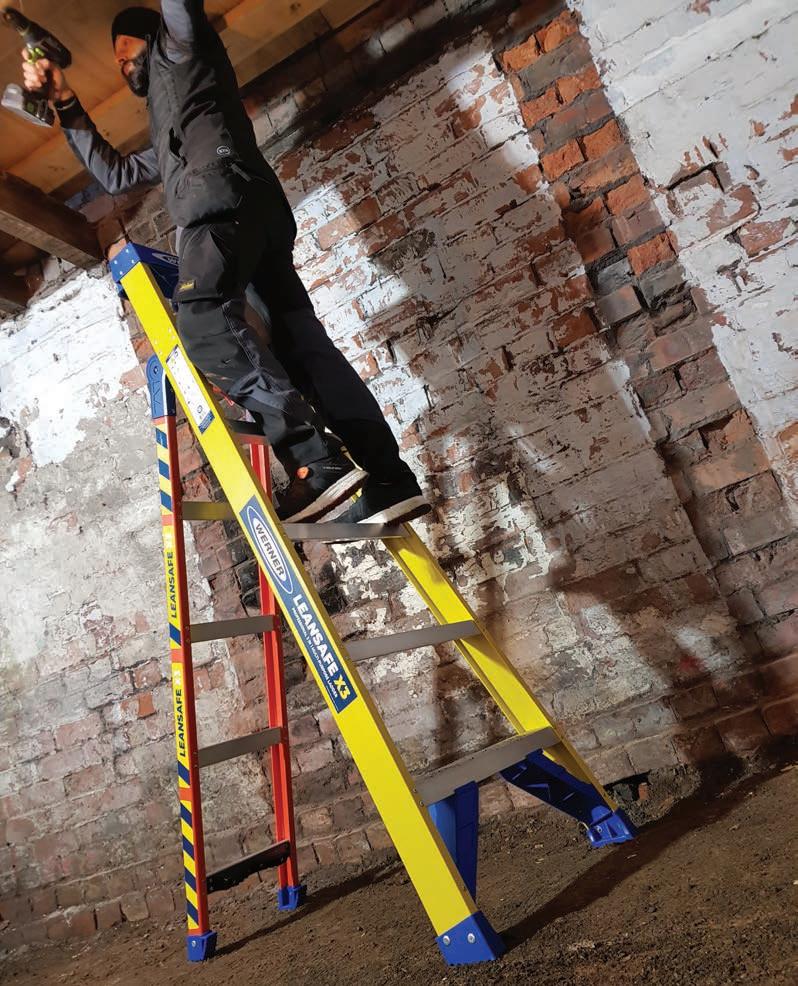
Tibby Singh — www.TibbySingh.com
Professional Builder’s Tibby Singh steps up to the Werner Leansafe X3 Fibreglass Ladder
Did you know falls from ladders account for an average of 14 deaths per year? This is a shocking statistic and something that is hard to comprehend. However, when you think about it working at height doesn’t mean when you’re on a scaffolding, anything above ground/floor level means you are technically working at height. That’s the reason why safety should be taken seriously wherever and whenever you’re working on site.
Recently I got my hands on a Werner Leansafe Fibreglass ladder and was looking forward to seeing what it had to offer – and, more importantly, if I felt safe. The first thing I noticed is that it’s a three in one ladder so not only can it be used as steps but it can also be leant up and even extended to gain extra height. This can be interchanged quickly – and singlehandedly – via a quick release system. As they say good things come in three’s.



Extended reach
When it’s in the closed position the height is 1.8m and in the extended ladder mode it’s more than double at 3.7m whilst weighing in at just 11.5kg. The unit is available in fibreglass and aluminium. The advantage of the fibreglass option is that it’s non-conductive, making it safe for trades working with wires.
The design of the ladder makes it incredibly sturdy and extremely durable so, when you’re up the ladder using tools, you do feel safe. I admire the fact that it also has a top with an integral tool tray which means all the necessary equipment for the job is close at hand and you don’t have to worry about them falling on the floor or going up and down the ladder like a yoyo. To top it off the top is designed to be leant against the internal or external wall corner, stud, pole or flat surface safely without rocking. Just when you think it does it all it is actually capable of more. With it’s slim rear design it allows you to fit it between framing studs, which means you can be closer to the working area and not have to reach over.
I didn’t think a ladder is capable of doing so much but it’s safe to say Werner’s Leansafe X3 Ladder is a step above the rest by taking the design to new heights!
FOR FURTHER INFORMATION ON THE WERNER LEANSAFE X3 FIBREGLASS LADDER VISIT WWW.RDR.LINK/BAP056
COMPACT BOLT CUTTERS
The 18 different tools in the Knipex CoBolt Compact Bolt Cutters collection range in size from 160, 200 through to 250mm, and can be used for cutting nails and screws or for cutting wire mesh or fencing. The precision cutting edges are made of induction hardened, chromevanadium high performance steel complemented by a particularly efficient lever action.
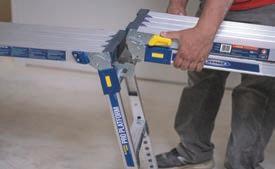

GET MORE DETAILS AT: WWW.RDR.LINK/BAP057
ADJUSTABLE HEIGHT & LINKING PRO PLATFORM
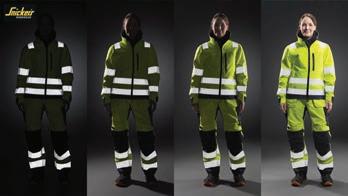
With the Werner Adjustable Height & Linking Pro Platform, end users can reach up to 2.51m and connect two or more platforms for a longer working surface – with no tools required. The extralarge 1.17m x 0.36m platform offers a broad standing space and, thanks to the linking element, there is the ability to double, triple or even quadruple the working area.
GET MORE DETAILS AT: WWW.RDR.LINK/BAP058
WHEELBARROW MIXER
Only weighing 50kg, Marshalltown’s new Wheelbarrow Mixer is lightweight and portable, and has a 3 cu.ft. mixing capacity. It also benefits from a high torque UKCA/CE approved 1/2HP 240V/50HZ electric motor with direct drive gearbox, and the rugged 24” steel drum spins at 28 RPM. It is easy to assemble and supplied with pedestal, 10” flat free tyres, removeable handles and can clear a 30” door opening.
GET MORE DETAILS AT: WWW.RDR.LINK/BAP059



WINTER JACKET
The Helly Hansen Workwear Oxford Winter Jacket is equipped with a Helly Tech Performance membrane and Primaloft insulation, keeping you warm, dry and comfortable in both rain and snow. The shoulder seams have been removed for durability on an otherwise high-impact area, but also maximises comfort when carrying a backpack or equipment. The garment is also available as a waterproof shell –without insulation – for spring or British summer conditions.
GET MORE DETAILS AT: WWW.RDR.LINK/BAP060
PROTECTIVE WEAR
Sustainability matched with the best protection standards for hazardous environments and foul weather is how
Snickers Workwear
describes the Protective Wear range. Base-, mid- and top-layer working clothes and accessories are complemented by work gloves, kneepads specialist protecwork and Hi-Vis clothing.
GET MORE DETAILS AT: WWW.RDR.LINK/BAP061
SPECIAL ANNIVERSARY PROMOTION
To celebrate a half century in the UK market, Makita has launched a 50th anniversary promotion, with the opportunity to claim free products with the purchase of selected items from its range. These include a free USB Adaptor (ADP05), DAB+ Site Radio (DMR110), 18V LXT 5.0Ah Battery (BL1850B) or 100-Piece Drill and Screwdriver Bit Set (B-53811).
FOR MORE INFORMATION ON THE PROMOTION AND ITS TERMS AND CONDITIONS, VISIT: WWW.RDR.LINK/BAP062
Save time, make money all year with the reliable, easy to use and clean, pneumatically powered, vibration free Pnu-Point pointing tool.
IN THE MIX
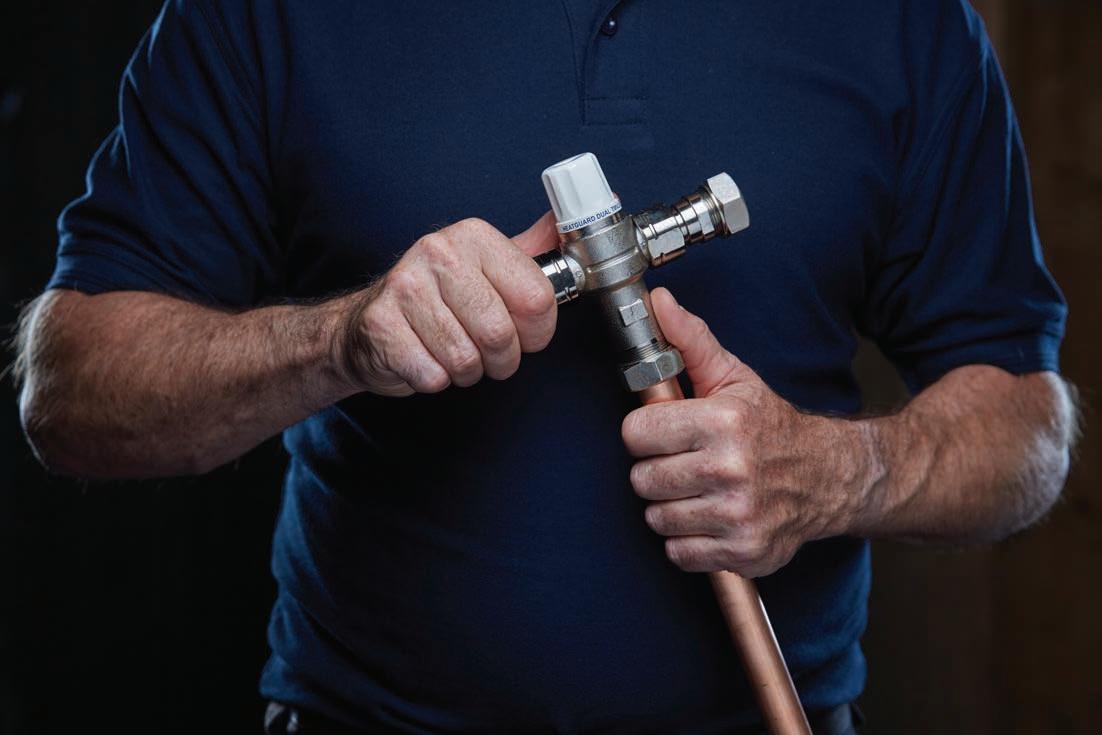
Eric Winter, RWC’s EMEA Director of Product Development, explains how thermostatic mixing valves (TMVs) can contribute to a smarter, more cost-effective plumbing system.
■ Safety factors
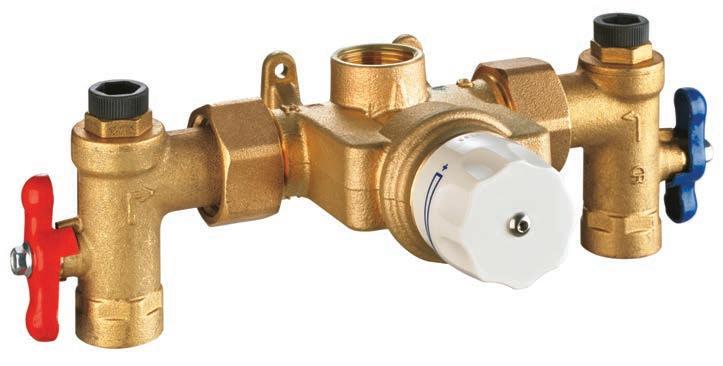
By mixing hot and cold water to deliver a consistent and pre-determined temperature, TMVs provide two vital safety functions – they help prevent scalding and, by allowing hot water systems to run at sufficiently high temperatures, they help protect against the buildup of Legionella bacteria in the pipework. For these reasons, TMVs are a necessity in all commercial and domestic new builds, properties undergoing a change of use, and in hospitals, care homes and other healthcare environments.
There are two levels of certification –TMV2 (domestic and commercial) and TMV3 (healthcare). The performance difference between them is essentially the speed and accuracy of operation and the application they are used in. For example, while a TMV2 can serve multiple outlets such as sinks in a gym, TMV3 applications recommend one valve for each outlet. In most non-domestic buildings, TMV2s are tested annually, while TMV3s must be tested at least every 6 months after passing their initial test following installation.
■ Functionality, servicing, and
performance
Because of their critical function, TMVs must comply with a broad range of regulations and British safety standards, including those specific to the NHS. The choice of valve clearly depends on the exact nature of the application, but RWC’s Reliance Valves comprises an extensive suite of TMV2 and TMV3 valves for every challenge, including Heatguard Dual TMV and Ausimix Compact or Ausimix Telescopic TMVs. Many have added value features such as isolators, test ports, and anti-tamper cap to improve functionality, servicing, and performance. All are fully compliant.
■ Energy saving
It’s for the reasons stated above that RWC’s TMVs are primarily known for their quality and safety. But the energy crisis and focus on climate change and sustainability has brought other features into focus – not least the need to save energy.
For gyms, healthcare settings, and multi-occupancy dwellings where large numbers of people are taking baths and showers, this is a particular concern. Research in the US suggests that hospitals typically use between 61 and 79% of their total energy on lighting, heating, and hot water. In the NHS, BMJ research suggests that most hospitals are braced for huge rises in their energy bills and the uncertainty around energy costs rising indefinitely only adds further pressure on facility managers. To take just two examples, Nottingham University Hospitals NHS Trust is budgeting for a 200%+ increase in 2023, while Leeds Teaching Hospitals NHS Trust expects to be paying £2 million extra a month for electricity and gas combined. For a service that’s already under severe financial pressure, this is extremely worrying.
TMVs can be used to help reduce the burden, for example, by installing a TBV or tempering valve, like the Masterguard, at the point of hot water generation. Allowing it to mix with the cold supply has a number of benefits. It allows water to be stored at high temperatures and then blended down to 55°C or 60°C as it enters the distribution system, increasing the amount of available hot water (compared with the tank capacity). Literally, making hot water go further.
Moreover, the addition of thermal balancing valves helps to maintain a constant temperature in the hot water system, which enhances the efficiency of TMVs. This means that larger buildings can maintain optimum output levels. At a time when people are looking to make even small additional savings, this potential to improve the control of hot water temperature can make a surprisingly big difference. ■ Renewable question
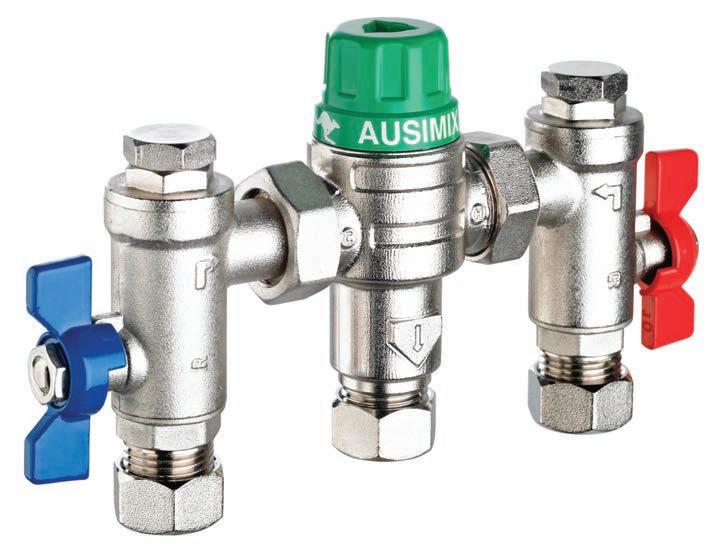
TMVs are designed to work best with water at a temperature of about 65 85°C, so one thing we’re often asked at RWC relates to whether they’re necessary or suitable for renewable systems in combination with solar panels or heat pumps. Our answer is yes, both as a failsafe mechanism, for added peace of mind, and for optimal efficiency. However, there are important things to bear in mind from a specification point of view.
With traditional gas boilers being slowly phased out, heat pumps are growing in popularity. And while they are an investment at first, they can reduce energy bills by over 20% compared to a new gas boiler, which over time will return the investment by means of lower energy bills. However, heat pumps run at much lower temperatures than conventional boilers, and special attention needs to be paid when specifying TMVs to be used in combination with a heat pump.
Similarly, when specifying TMVs in combination with the use of solar panels, it is important to remember that renewable energy resources run at much higher temperatures than conventional energy resources, often reaching 90°C. TMVs specified alongside solar panels will need to be able to withstand these extreme temperatures without compromising their functionality. As each project is unique, as a manufacturer, we would always recommend reaching out to our technical team to find the right TMV for the application in question.
Of course, to optimise efficiency, it’s necessary to match the right valve with the application. On one hand, undersizing can lead to pressure drops, starved outlets and inefficient flow. On the other, over specification can produce unnecessarily high flow rates, leading to water waste (and unwanted noise) if there are fewer outlets than the valve is designed to serve. To ensure the right application, simply check the technical data, or – in RWC’s case – the tech team is always on hand with expert support.
■ Hot water sustainably
TMVs were initially developed to help enhance system and personal safety, but their capabilities extend beyond simply that. They have value in terms of efficiency and energy saving. These qualities can be amplified even further by combining them with other valves to deliver sufficient hot water, sustainably.
They may not be the sole answer to the pressing climate and energy crises we’re facing, but as part of any forwardthinking plumbing system, they’re definitely part of the solution.
FOR MORE INFORMATION ABOUT RWC AND THE RELIANCE VALVES RANGE OF TMVS AND TBVS VISIT: WWW.RDR.LINK/BAP065
CUTTER ‘BOVE
Professional Builder hears about a tool which can save time, effort and money for plumbing and heating installers.
Step 1
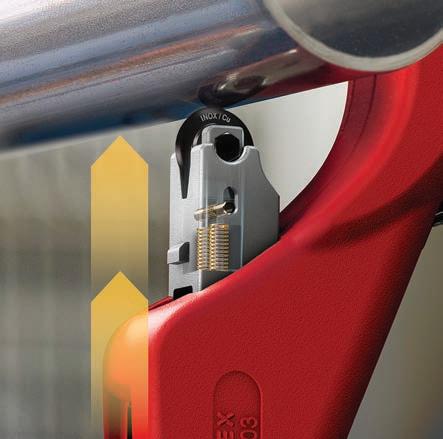
To operate the tool place the open TubiX XL pipe cutter on the pipe. Position and lock the spring-loaded cutting wheel into place on the workpiece using the QuickLock locking mechanism. The cutting wheel on the TubiX XL is made of quality ball-bearing steel while the metal housing is a light and durable magnesium.
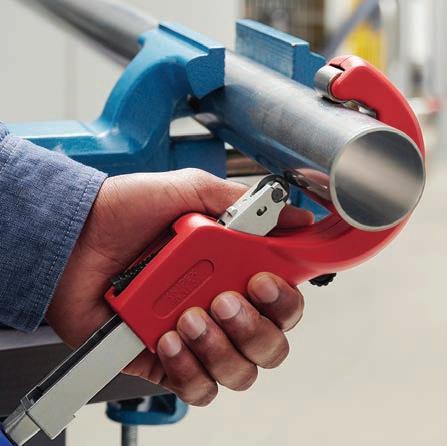
Step 2
The pipe is cut by turning the tool, and the clearance between the cutting edge and the pipe can be freely adjusted with the ergonomic feeding barrel.
Pliers’ specialist Knipex has launched the TubiX XL Pipe Cutter, big brother to the TubiX pipe cutter it launched in 2020. Designed to be precise and quick, the tool cuts pipes from 6 to 76mm (1/4’’ to 3’’) and a wall thickness up to 2mm and can also be used by electricians to cut rigid steel conduit and for stripping steel wire armoured cables.
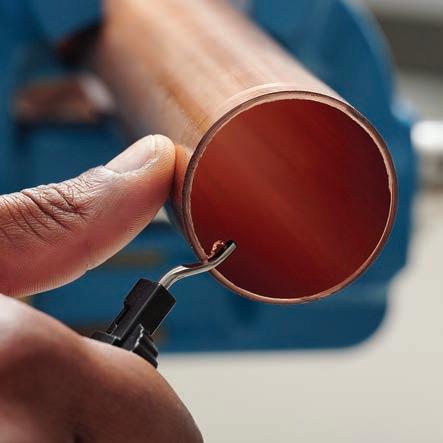
Step 3
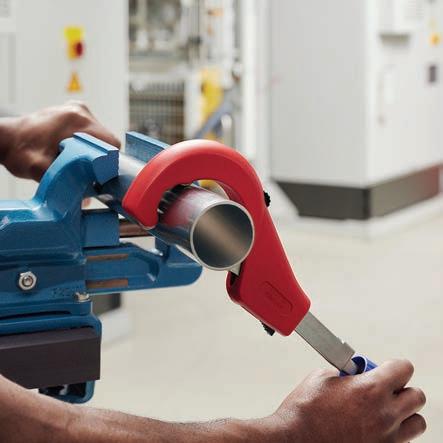
The cut surface can then be deburred if necessary, with a special tool kept in the TubiX.
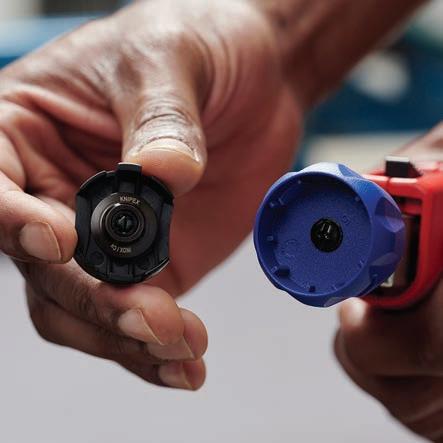
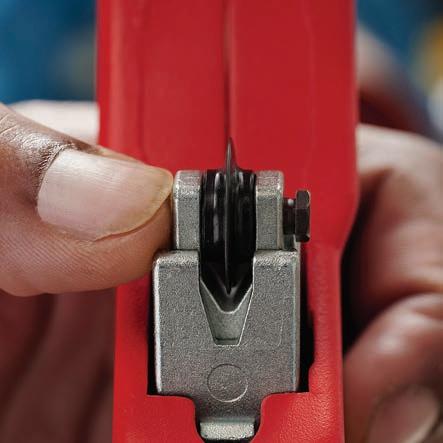
Step 4
The needle-bearing and spring-loaded cutting wheel can be exchanged without any tools. A spare wheel is also located in the handle cap. The TubiX XL has been designed to make professionals’ lives easier, saving time money and effort and both the XL and its smaller brother TubiX would be handy additions to a toolkit.
FOR MORE INFORMATION ON THE TUBIX VISIT: WWW.RDR.LINK/BAP066 TO WATCH A VIDEO ON THE TUBIX VISIT: WWW.RDR.LINK/BAP067





Smith & Jones



WOOD PROTECTION
HARD AND FAST

Tough on stains, dirt & scratches – and quality results every time. That’s the promise for Armourflex Hardwax Oil, and you’ve got the chance to try it for yourself!
For centuries people have admired the beauty of wood, with generations using this versatile material in the construction of homes and workplaces. Traditionally, combinations of beeswax and linseed oil were used for protection, offering a natural appearance whilst providing a layer of defence against water ingress, scratches and the inevitable surface damage which occurs over time. Beeswax and carnauba in particular have a longstanding reputation for use in furniture protection but their application is labour intensive and high maintenance compared to modern finishes.
Customer trends are now showing a revival of traditional materials in the name of sustainability, incorporating naturally durable wood, such as oak, into building design. The market renaissance of such materials requires treatments able to display and conserve the opulent feel they impart to a home or office space. However, premium material quality comes at a premium price so the most costeffective solutions must not skimp on performance, as careful early maintenance pays dividends to protect this long-term investment.
High quality
Barrettine is a Bristol-based, UK manufacturer specialising in premium Professional, Trade and DIY wood coatings, with over 140 years of holding quality and service at their heart. With access to highly respected global suppliers, the company use the highest quality raw materials to ensure the toplevel durability expected from Tradeperformance products.
Its recently released liquid Hard Wax Oil is the latest addition to the ArmourFlex range of high-performance specialist coatings, designed to protect internal wooden surfaces such as floors and stairs. It offers a vastly easier application than the frequent, repetitive buffing of traditional beeswax films.
Whereas beeswax is a stiff paste, Armourflex Hardwax Oil is a flowing liquid so it penetrates deeply into the wood. This allows it to cure within the wood grain in a strong protective hold, enhancing the natural beauty and authenticity. This enhancement gives more depth and interest to the wood shades yet also offers a gentle, natural finish and that enables the surface to breathe.
Armourflex Hardwax Oil is also food and toy safe when dry, certified by EN 1186:2002 & EN71:3. As an elegant and
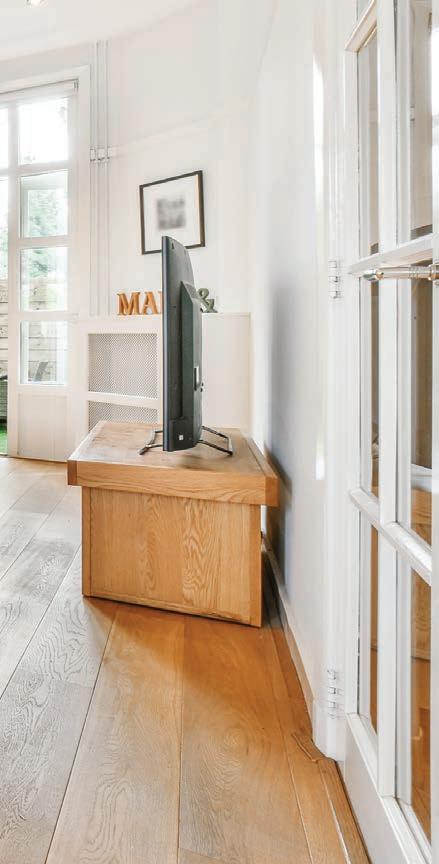
SPECiAL OFFER
Celebrating the newly released Armourflex Hardwax Oil, Barrettine is offering an opportunity to redeem 30% off the purchase price from selected stockists by leaving a review!
Trade confidence is already growing in this elegant and protective finish and the manufacturer is keen to hear what more the trade has to say, so here is your opportunity!
Scan the QR code or use the rdr.link below now and head over to the Barrettine stockist page.
protective finish, it will complement a range of modern and classic interior styles, enriching the colour of the wood whilst protecting the floor or surface against liquid spills and scratches. The protection from Hard Wax Oil comes primarily from its threedimensional hold within the wood grain which offers excellent surface waterresistance and also won’t crack, peel, flake, or blister, making it highly durable and offering long lasting, low maintenance protection.
If surface damage does occur then spot repairs can easily be undertaken without the effort of renovating the entire room, saving both time and money. This gives an advantage over other floor coatings, avoiding the need for lengthy re-sanding of the wooden surface before re-application.
The product is supplied ready to apply for easy application and Armourflex Hard Wax Oil in Matt and Satin finishes is available from Barrettine Stockists now.


WWW.RDR.LINK/BAP068
FOR FURTHER INFORMATION ON ARMOURFLEX HARD WAX OIL VISIT WWW.RDR.LINK/BAP069


LOFT IN SPACE
According to government data, there are around 8 million uninsulated, poorly or under insulated lofts in the UK. Which means there will be plenty of opportunities for builders over the coming months and years to help households improve their home energy efficiency by installing or upgrading their loft insulation.
As with any refurbishment project, a cold roof insulated at ceiling level will need to meet the limiting U-value (minimum thermal performance standards) set out in Approved Document L. This was updated in June 2022, so a cold roof insulated at ceiling level will need to achieve a U-value of 0.16 Wm2K.
Installing Knauf Insulation’s Loft Roll 44 to a depth of 270mm will meet the minimum standards, but we know that, where energy efficiency is concerned, the thicker the insulation, the more effective it will be at preventing heat transfer. For this reason, many new homes are now being built with loft insulation to a depth of 400500mm. So, if you’re doing a loft installation, advise your customers to do the same to help cut their bills as much as possible.
Bradley Hirst, Technical Services Manager at Knauf Insulation, explains why loft insulation should be installed to a depth of 500mm.
Top up or replace?
If the loft already has some mineral wool insulation installed, builders will need to consider whether it can be topped up or if it needs to be replaced. Mineral wool insulation will last for 50 years or more, so providing it’s been installed correctly and isn’t damaged, it will be fine to insulate over the top.


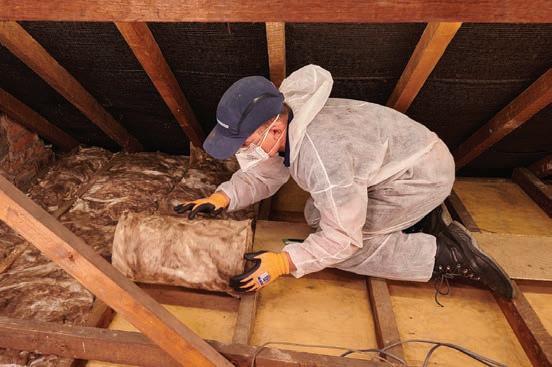


Damage is unusual but occasionally it may have been torn or compressed if items such as boxes have been stored on top of the insulation. It’s much more likely that it has been fitted incorrectly or disturbed after installation. So, builders will need to check that it fits snugly between joists, goes to the edges of the roof and is butted closely together to ensure there are no gaps. If it is damaged or has been poorly fitted, it’s best practice to remove the original insulation.
Get the best performance
Insulation acts like a quilt. Imagine you’re tucked up in bed – if there’s a gap, the warm air will escape, and you’ll get cold. The same is true of loft insulation, so good installation is essential in ensuring maximum energy efficiency.
If the loft has no insulation, start by sealing any gaps that could allow air to leak into the loft from the room below using sealant and tape. To reduce fire risk, isolate any heat-producing electrical fixtures, such as downlights, with non-combustible protection covers and reroute any cables under a high electrical load so they can be positioned over the top of the insulation.
When installing mineral wool insulation, it’s easier to start in the eaves and work towards the loft hatch. Many loft insulation products are combi-cut (perforated) for standard joist centres, but if the joist spacing isn’t standard you’ll need to cut the roll using a saw or knife.
Remember to unwrap the insulation in the loft. Knauf Insulation glass mineral wool insulation is compressed so there’s more product per pack. This means you can fit more insulation into your van (which also reduces transport-related carbon emissions). But when you unwrap it, our Loft Roll insulation will recover to up to ten times its compressed thickness. So only open it where you plan to install it!
The first layer of insulation should be installed snugly between the joists to the same depth as the joist. So, if the joist is 100mm deep, the first layer of insulation should also be 100mm deep. Position the end of your insulation between the joists and curve it down around the edge of the loft floor, into the wall head until it meets the top of the wall insulation. It’s important to leave a 50mm gap between the top of your loft insulation and the roof, to ensure air movement and prevent condensation.
Make sure the ends of the insulation are butted together so there are no gaps that can reduce performance.
Subsequent layers of insulation should be installed at a right angle to the first. It’s best to install the second and third layers together so you can achieve a depth of 500mm without compressing the insulation as this will reduce its thermal performance.
By following this best practice guidance, builders will be able to deliver successful loft insulation projects and play a critical role in improving the energy efficiency of homes across the country.
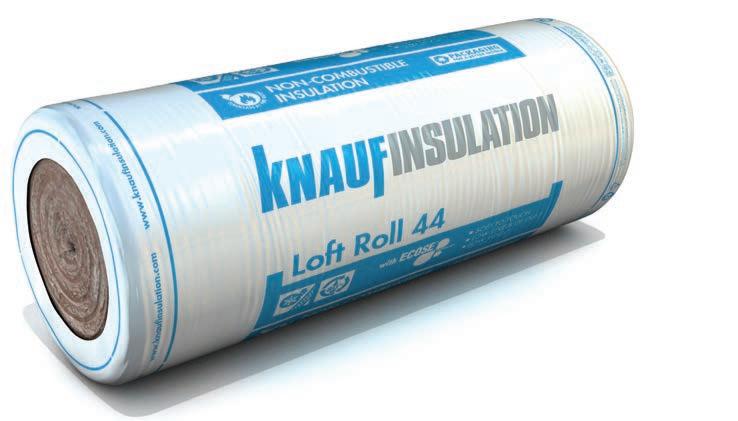
FOR FURTHER INFORMATION ON KNAUF INSULATION’S LOFT ROLL VISIT WWW.RDR.LINK/BAP070


FIGHTING


Kirk Smith of Allegion UK discusses fire door neglect and how to spot the potential faults that could be compromising your fire safety procedures.
A fire door is a complete door assembly, comprising of a doorset fit with a door frame, leaf, essential hardware, edge seals and integral panels. In the event of a fire, not one of these elements can fail, and so to meet the necessary standards, a fire doorset must pass one or more of a series of standardised tests, confirming its certification and FD ratings. Generally, there are eight core areas to consider when conducting regular risk assessments and spotting potential faults:
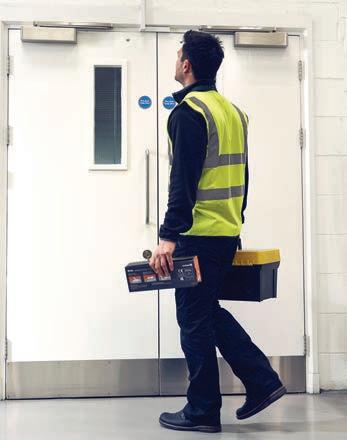
Door furniture

“A handle should always remain installed on a fire door and its screws tight. Boltthrough fixings pass right through the door and the lock or latch case and will strengthen the installation of handles by preventing the screws from moving or becoming loose. Check whether the handle operates smoothly and returns freely to a horizontal position after use, too. Finally, if the fire door in question is on an escape route, it must open in the direction of travel, without the use of a key. Keep it simple, but effective.”
Hinges
“Hinges are a necessary pivot action fixing that provides the movement to a door. A standard height fire door requires the installation of three hinges minimum, with intumescent pads fitted. A door standing over 2.2 metres will require four hinges. This will prevent the door from warping in a fire due to its weight and so, should you see a fire door only hung on two hinges, it must be changed. Again, screws must be fitted securely, and the hinges themselves must be free of metal fragments and oil leakage as this could indicate signs of wear. When it comes to certification, check for CE or BS EN 1935 marks.”
Locks and latches
“Locks and latches help to keep doors held shut and so must be fixed firmly and working correctly. Upon inspection, it’s
important to check whether the latch engages fully into the strike plate and whether the door can be held firmly in place without rattling. Failure to do so may indicate faulty or damaged hardware. Like hinges, check for metal dust deposits – typically located on the latch bolt or strike plate – as this could also show wear or damage.”
Door closers
“Door closers facilitate the operation of a fire door and must be UKCA and CE marked and tested to EN 1154. When opened, a fire door should fully engage into the door frame every time, shutting tight by use of its own self-closing device. When conducting checks, the trick is to open a door to 5° or 75mm, and upon letting it go, it should close and engage the latch successfully. Failing to do so could indicate the door closer has been incorrectly installed or damaged and, therefore, needs adjustments or replacing. Adjustments can be made to the closing power and speed of door closers, and in busy environments, such as schools and hospitals, a prolonged closing action is useful, giving people extra time to pass through the doorway.”
Hold open devices

“Buildings with high footfall may benefit from approved, electromagnetic hold-open devices tested to BS EN 1155, which permit open fire doors that automatically release to close in the event of a fire. Naturally, these systems are more complex and regular maintenance is mandatory, so it’s vital to spot any potential faults, such as the door straining against its self-closing device upon operation. Should an electromagnetic hold-open device not release the door when a fire alarm is activated, a problem has occurred and must be resolved immediately.”
Exit devices


“Exit devices are designed to provide safe and effective escape through a doorway with minimum effort. All panic and emergency exit devices must be functioning correctly, with fixings on the operating device, bolts and strikes tightly fit. Emergency exit devices and panic exit devices should be tested to BS EN 179 and BS EN 1125 respectively, as well as UKCA and CE marked. Aside from their mechanical operation, it’s critical to keep emergency exits clear and without obstruction – assisting a quick escape when called upon.”
Door seals
“When rated FD30 or FD60, a fire door is certified to resist smoke and fire for 30 or 60 minutes, respectively. For this to remain true, a doorset must be fitted with intumescent seals which, in the event of a fire, expand significantly to close the gap between the door and its frame. Intumescent seals should track continuously around the frame or door leaf and must remain in good condition, intact and undamaged. If you can see excessive gaps between the side of the door and the frame, a fire door may be ineffective. A maximum gap of 3mm is recommended around all fire doors and can be assessed with simple gap tester tools.”
Signage
“‘Fire Door Keep Shut’ signage must be fitted to both sides of a fire door. Additionally, ‘Automatic Fire Door Keep Clear’ signs must appear on fire doors with hold open devices and ‘Fire Door Keep Locked’ signs must be fitted to doors without self-closing devices – which can commonly be found in storerooms and cupboards.”
A complete and functional fire door is a prerequisite for fire safety and regular maintenance periods are required to ensure they retain their standard while in operation. The first step is to understand the various components of a fire doorset and the potential faults to look out for when evaluating its condition. Should any doubt linger, it’s crucial to seek out professional advice immediately. Checks can save lives but where action is an obligation, knowing what to look out for is only half of the responsibility.
FOR INFORMATION ON PRODUCT SELECTION AND INSTALLATION HEAD TO THE ALLEGION DOWNLOAD CENTRE AT WWW.RDR.LINK/BAP071
FOR GENERAL GUIDANCE ON SERVICE AND MAINTENANCE VISIT WWW.RDR.LINK/BAP072
FOR INFORMATION ON THE FIRE DOOR INSPECTION SCHEME VISIT WWW.RDR.LINK/BAP073

PROFILE PITCHED ROOFLIGHT

Energy efficient made to measure pitched roof lights with a minimalist low-profile appearance are now available from Roof Maker. The unvented SheerLux rooflight sits flush or slightly lower than the surface of a pitched roof (depending on the thickness of rooftiles), creating an uninterrupted roofline suitable for newbuild, retrofit and some heritage projects.
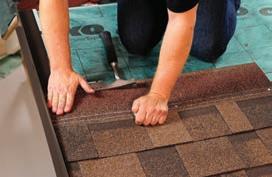
GET MORE DETAILS AT: WWW.RDR.LINK/BAP074
SHINGLE ROOFING TILE
Extensions, ‘posh’ sheds and garden buildings are all within the remit of the Metrotile Cambridge Xtreme 9.5 shingle. Installation is simple and straightforward, the new shingle comes in natural tones and colours, and the material is water shedding and weather resistant. Extreme pitches from as low as 9.5 degrees all the way up to 90 degrees can be achieved.
GET MORE DETAILS AT: WWW.RDR.LINK/BAP075
WOOD FILLER
Ready to use Toupret Wood Filler and powder Wood Repair Filler, are both easy to apply and sand, can be drilled and screwed. They are also low odour, and can be used on all types of wood, including exotic species, chipboard or plywood, are compatible with any conventional paint, varnish or stain, and suitable for interior or exterior use.
GET MORE DETAILS AT: WWW.RDR.LINK/BAP076
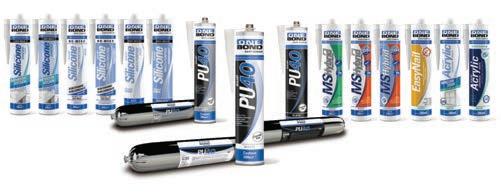
GENERAL BUILDING
LVT
Available to specify across the Signature, Spacia and Form collections Amtico Bio is a bio-attributed LVT option, manufactured using sustainable PVC derived from renewable raw materials. This process saves more than 90% on CO2 emissions released in production compared to fossil fuels.
GET MORE
DETAILS AT: WWW.RDR.LINK/BAP078
MIXER TAPS
Two single lever mixer taps are available within the PJH Prima+ collection. Mosa includes a single lever tap (67° handle operation) with pull out spout, and a single lever, quarter turn, adjustable spring mixer tap with 360° swivel spout, both finished in chrome, and dual jet flow so that the tap does not become uncomfortably hot to the touch.
GET MORE DETAILS AT: WWW.RDR.LINK/BAP079
GAS BOILER
Thanks to the ‘ON’ technology in the Navien NCB700 ON gas boiler the unit is capable of delivering hot water for up to three bathrooms simultaneously. It maximises recirculation of domestic hot water (DHW) to reduce water wastage and offers flow rates up to an industryleading 22 litres per minute (at 35°C temperature rise) – without the need for a hot water cylinder.
GET MORE DETAILS AT: WWW.RDR.LINK/BAP080
THERMOSTAT
ADHESIVES AND SEALANTS
Resistance against sunlight, temperature variation, humidity and even ozone are just some of the benefits of the OneBond brand from Saint-Gobain. In addition, the polyurethane solutions deliver on high puncture, tear and abrasion resistance, low gas permeability and antimicrobial properties, whilst MS-Hybrid sealants are multi-purpose products.
GET MORE DETAILS AT: WWW.RDR.LINK/BAP077
The RTP4 Touch programmable room thermostat controls heating and hot water systems via combi, system or heat only boilers. When installed with the ESi WIFI hub, homeowners and tenants heating and hot water can be controlled via Alexa or the ESi Centro App. OpenTherm technology can also make savings of up to 15% on gas usage.
Use our digital reader enquiry service for further information online GET MORE DETAILS AT: WWW.RDR.LINK/BAP081


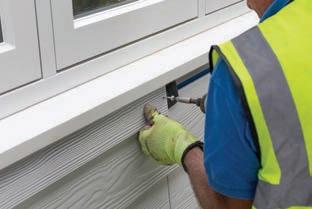
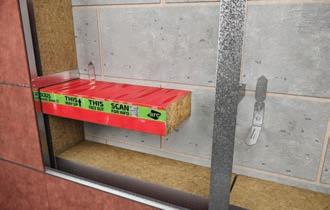
TRADE MEDIA
ECOPROCAL STORAGE HEATER CALCULATOR
Installers fitting electric storage heaters can find support with the Elnur ecoProCAL online calculator tool. Using measurements relating to the property’s insulation, number of windows, walls and rooms, it can determine which heater and, more importantly, how many heaters are needed.
GET MORE DETAILS AT: WWW.RDR.LINK/BAP082
HAVERLAND WINTER 2022/2023 CATALOGUE
The Haverland Winter 2022/2023 catalogue includes smart, electric and ceramic radiators. There’s also the latest in electric towel rails, outdoor heaters, and air treatment products. End users can stay connected with all of these heating systems through WiFi, GPS or Bluetooth systems in the exclusive Haverland Apps.
GET MORE DETAILS AT: WWW.RDR.LINK/BAP083
PODCAST
The impact and the prevention of serious aches, pains and strains is the subject of a new podcast from the Health and
Safety Executive
(HSE). Supporting the Work Right Construction: Your Health. Your Future campaign, the episode features Matt Birtles, Principal Ergonomics and Human Factors Consultant at HSE.
GET MORE DETAILS AT: WWW.RDR.LINK/BAP084
ROCKWOOL CPD
A Rockwool CPD module will enhance industry understanding of regulations and provide guidance on determining relevant non-combustible classifications in flat roofing systems. It complements the whitepaper ‘Flat roofs: Managing fire risk in the fifth façade’ and other technical information about the insulation of flat roofs.
GET MORE DETAILS AT: WWW.RDR.LINK/BAP085
CEDRAL SELECT ONLINE PLATFORM
Cedral Select is an online platform that puts homeowners in touch with certified installers across the UK. To become a Cedral Select Professional, applicants must pass an initial installer assessment and then comprehensive product training is provided. A technical validation is then completed on a recent job site.
GET MORE DETAILS AT: WWW.RDR.LINK/BAP086
ARC VIDEO
A new video will support the installation of the ARC Open State Cavity Barrier (OSCB). The product has been designed to stop the spread of fire in ventilated cavities. The manufacturer is also providing additional guidance on how to install adjacent products.
GET MORE DETAILS AT: WWW.RDR.LINK/BAP087
GRANT UK NET ZERO HEATING SHOW PODCAST
Three brand new episodes of Grant UK’s Net Zero Heating Show are now available to download and listen to via the mainstream podcast platforms. Series Two of the Podcast sees Grant UK’s hosts and guests discuss the heating sector, heat pump myths and retrofit installations.
GET MORE DETAILS AT: WWW.RDR.LINK/BAP088
NHBC RESIDENTIAL CONSTRUCTION STATISTICS PORTAL
The latest information on the housing market is now available via a self-service data portal. The NHBC Residential Construction Statistics portal will track the pace of construction through registrations, starts and completions at a weekly level, as well as offer access to extensive historical data, geographical breakdowns, visualisation tools and custom views.
GET MORE DETAILS AT: WWW.RDR.LINK/BAP089
Use our digital reader enquiry service for further information online


HEAR TODAY, GONE TOMORROW
Noise is a major and continual problem both for our health and the environment. Here, the team at Hellberg Safety examine the ways that employers and employees can take a proactive approach to hearing protection on-site.
Noise pollution is with us all day, every day and, while more recent legislation has been enacted to regulate its effect on our environment, Health and Safety at Work regulations have been in place for some years to ensure safety and wellbeing in the workplace.
Noise-induced hearing loss is one of the most commonly reported physical diseases in the world – particularly in the workplace. It’s an accumulated disease that increases at every point of overexposure to noise and the bad news is that hearing loss could be permanent. The good news is that it is easy to avoid!
It’s the law!
By law employers have to assess and identify measures to eliminate or reduce
risks from exposure to noise so that the hearing faculties of employees can be protected. In low-risk environments preventative actions can be relatively simple and inexpensive.
Where risks are high, however, they have to be assessed and managed using control actions that include the provision of appropriate hearing protection equipment as well as information, training and health surveillance for employees.
Employers are required to provide employees with properly maintained hearing protectors, ensure they use them properly and establish hearing protection zones where the use of hearing protection is compulsory.
At Hellberg Safety we recommend always reducing noise levels to a maximum of 75 dB, simply because maintaining dB levels can be affected by a number of external factors.
If you’re unsure of what the local noise level is, a useful rule of thumb is that if you need to raise your voice to be heard when you’re about three feet or so from someone else, the ambient noise level around you could be a risk to health.
Whatever a manufacturer’s product specification or protection level may be, the attenuation of noise provided by a pair of hearing protectors can decrease due to insufficient fitting, misuse and poor maintenance. Long hair, beards and glasses can affect the fit of the protector, hence the greater the effective noise abatement, the more your hearing is protected.

It is important to remember though, that too much attenuation can be dangerous too, especially if it stops you from hearing warning signals. That’s why it is really important to choose the correct hearing protection based on your needs and assessed risk levels.
Assess risk and protection together
Risk assessments for noise hazards can be obtained through a professional service – and they’re important in ensuring proper health and safety responsibility –but it is a relatively straightforward process to identify the level of a risk based on available noise hazard indicators and then source a suitable product solution. For example, and as an indication of a noise level in relation to dB measurements, a fairly quiet conversation in an office may reach 60 dB, a vacuum cleaner up to 70 dB.
On the upward scale of noise, a food blender can reach 80 dB and a chainsaw 120 dB. To give an idea of the latter two’s risk to hearing, extended exposure to the noise of a food blender requires hearing protection, while exposure to the noise of even the most basic chainsaw can be potentially painful to your hearing without proper protection. Anything above that offers considerable potential for serious and permanent damage to hearing.
Choosing the right hearing protection
Never assume that a basic pair of ear defenders will protect against high-risk noise. Always use hearing protection when exposed to harmful noise and, if necessary, choose a protector adapted to your work environment, i.e a product with ‘level dependent hearing protection’.
To identify an appropriate hearing protection product, check out the noise sources graduated chart within this article. Within that chart, identify the hazard level of the noise source – green is low-risk, yellow is medium-risk, red is high-risk. Then select the appropriate type ear defenders – look for the colour coded ear-piece bands which define the different protection levels.
Protection Level 1 – green – is designed for general industrial environments and an appropriate choice for low to medium dB noise levels and medium to high frequency noise (Hz). Protection Level 2 – yellow – provides the best protection for high frequency noise (Hz) and are appropriate for medium to high dB noise levels. For extremely high noise levels, Protection Level 3 products –the red band –are the only suitable choice.
It’s also important to consider the type of protection required – passive or electronic. Passive hearing protectors are self-contained ear defenders which block harmful sounds. They have no built-in electronics but provide excellent protection against loud and dangerous noise. Electronic hearing protectors have added technical functionality which facilitates wireless or Bluetooth communications and emergency signalling between workers.
So choose hearing protection products that are appropriate for specific risk environments. Make sure products fit correctly and are comfortable during the entire hazard exposure time at work. You should even consider using them if you’re mowing the lawn or strimming at home –the noise hazard and its potential effect on your hearing is the same.
You should ensure 100% wear time in noisy environments and remember that the use of eyewear can reduce the hearing protector’s attenuation of between 3-8 decibels –if possible, select thin eyewear frames.
Finally, your health and wellbeing onsite is of huge importance, so choose your PPE products carefully, understand how they’re protecting your health and wellbeing and ensure they’re used properly for maximum beneficial effect.
With that in mind check out the Hellberg Safety website:
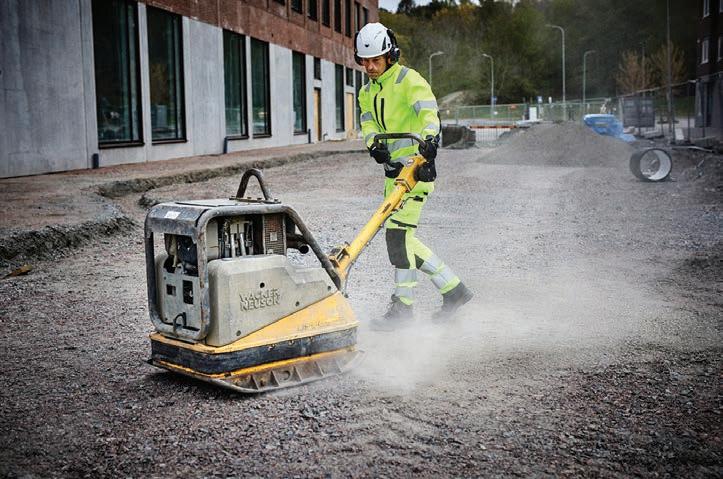
(WWW.RDR.LINK/BAP090) where you’ll find all the information you need on choosing precisely the right kind of passive or active hearing protection for whatever you’re doing or wherever you’re working on-site.
BROWSE HELLBERG SAFETY’S RANGE OF NOISE PROTECTION PRODUCTS AT: WWW.RDR.LINK/BAP091
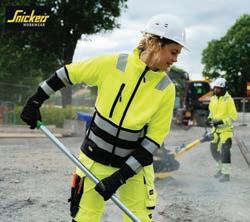
GLOVES
The range of specialist thermal solutions from the Unigloves Nitrex Thermal Industrial Gloves range will not only protect against cold. Wearers will also benefit from superior wet and dry grip, liquid resistance and abrasion and cut protection. There are three thermal gloves available –Nitrex 299T, Nitrex 360FCT and Nitrex 370W.
HI-VIS
An extended range of sustainable and functional High Visibility working clothes for light to night, dawn to dusk is available from Snickers. The jackets, trousers, shorts, toolvests, shirts and fleeces all work together to satisfy the requirements of Class 1, 2 and 3 protection levels, and the requirements of the EN 20471 standard for high visibility warning clothes.

GET MORE DETAILS AT: WWW.RDR.LINK/BAP092 GET MORE DETAILS AT: WWW.RDR.LINK/BAP096
SAFETY EYEWEAR
The uvex i-range comprises three models that protect against a wide variety of workplace hazards – i-lite, iguard and uvex i-guard+. They all feature large, flat lenses for an unrestricted field of vision with an xtended sideshield to provide additional protection. In addition, i-range planet features recycled and bio-based materials.

GET MORE DETAILS AT: WWW.RDR.LINK/BAP093

LIFELINES
In developing the MSA Temporary Horizontal Lifeline, design engineers have opted for galvanised steel cable to maximise durability. Complex, timeconsuming set-up processes – typically requiring more than one pair of hands –have been replaced with a faster, simpler approach that takes the guesswork out of correct locking and tensioning.
GET MORE DETAILS AT: WWW.RDR.LINK/BAP094
TELESCOPIC LADDER

Following a recent study by the East of England Trading Standards Association (EETSA) and the Ladder Association about the safety of some telescopic ladders on the market, Werner is urging companies to only purchase from reputable manufacturers. It is important to check that it complies with European Standards, for example, in order that it is safer to use. To help when choosing a telescopic ladder, The Ladder Association has produced a handy safety guide for users.

GET MORE DETAILS AT: WWW.RDR.LINK/BAP095
NOISE-INDUCED HEARING LOSS
Smart Alert, a new and intelligent system from Minuendo is aimed at preventing noise-induced hearing loss (NIHL). Ergonomic earplugs, which can be worn on their own or under ear defenders, protects against noise while supplying the end-user with natural sound: maintaining directivity, situational awareness, and communication with co-workers.
GET MORE DETAILS AT: WWW.RDR.LINK/BAP097
PPE
Designed to meet the needs of a diverse workforce, rather than the ‘average’ worker, Cromwell has launched an inclusive range of personal protection equipment (PPE) products. Halo is designed for most sizes, shapes, cultural needs and gender, all certified to meet the latest safety compliance standards.
GET MORE DETAILS AT: WWW.RDR.LINK/BAP098
WORK AT HEIGHT
The Taylor Lane Timber Frame Top Hat Gantry Walkway method is a new work at height technique for use when constructing roofs which require top hat trusses. For ease and better understanding, Taylor Lane has made a best practice video which gives a step-by-step guide to the new method. Use the rdr.link below to access it on YouTube.

QCan I retrofit air con to my Ford
Transit van? I have a 2017 Ford Transit van that came without air conditioning. In the summer months, it is a pretty hot and sticky ride. Do you know of any companies that can offer an aftermarket fitment?
AIt’s a big job, which will probably set you back £2,000+ before VAT. I’m unable to recommend a specific company, but your local Ford dealer may be able to help. However, the cheapest option will probably be an independent garage that specialises in air conditioning.
QDoes my Volkswagen Caddy van
use a cam belt or timing chain? My 2018 Volkswagen Caddy 1.0-litre TSI is booked in for its service and MoT. A short while ago they phoned to say that the cam belt and water pump are due for a change. Does this van use a cam belt? And why do I need to have the belt and water pump changed at the same time?
AThe 1.0 TSI petrol Caddy van uses a cam belt. I’d suggest getting it changed every five years or 60,000 miles (whichever comes first). It’s a good idea to change the water pump at the same time, as a pump failure can be just as catastrophic for the engine as a belt snapping. Q How can I upgrade my Euro5
Nissan Navara’s engine to meet the ULEZ standards? I’m going to buy a 2016 Nissan Navara. How much would it cost for me to upgrade it for the London ULEZ?
AIt is not feasible to upgrade a Euro5 Navara to Euro6. These are two very different engine emission standards that are verified when the vehicle is first designed and built. And even if you could upgrade the engine, the costs would likely exceed the value of the pick-up. And it is unlikely Transport for London would recognise or approve such a modification for an exemption from the ULEZ.
QAre the engines in the Volkswagen
Transporter T5 reliable? I need a practical and dependable van but my budget will only stretch to a used Volkswagen Transporter T5 from 2004 to 2008. Are the engines in these vans any good?







Do you have a commercial vehicle problem? Honest John Vans has the answers you need. van with a Daniel Powell of Honest John Vansplan
Do you have a van question that you can’t find the answer to? Are you struggling to choose a van or pick-up for your professional needs? Email pb@hamerville.co.uk with your question and Honest John Vans will provide you with the answer.
AThe 1.9 and 2.5 diesels are good engines, but the van you buy will only be as reliable as its service history. As a minimum, the van should have a maintenance record that shows a yearly service and oil change. Mechanically the T5 is robust, but flywheel failures are common. Signs of failure include rattling from the engine, juddering or vibrations through the steering wheel.
QShould I buy a petrol or diesel
van? I need to buy a newish Euro6 van. Should I buy a diesel or petrol?
APetrol if you plan to use the van for trips of 15 miles or less on a daily basis. Diesel if you travel more than 15 miles. It’s important to note that diesel vans are not suitable for lots of short journeys, as this will not allow the engine to reach its optimum operating temperature. It will also prevent the DPF (diesel particulate filter) from successfully completing its regeneration cycle – which is required to burn off the soot it collects and prevent a costly blockage. Honest John Vans is the website that champions for fairness to van owners by publishing expert, unbiased information to help builders make informed choices about their vehicles.





FOR MORE VAN BUYING ADVICE, VISIT: WWW.HONESTJOHN.CO.UK/VANS OR TYPE “HONEST JOHN VANS” INTO YOUR ONLINE SEARCH ENGINE, OR VISIT WWW.RDR.LINK/BAP100
ABOUT THE LIMIT
All newly launched van models in EU countries are now required by law to be fitted with speed-limiting technology and experts are saying “it is only a matter of time” before the UK follows suit.

The new EU rules came into effect on 6 July and initially apply to all-new models being launched, before being extended to all new vans and cars from July 2024. All vans will get Intelligent Speed Assistance (ISA) technology that will use GPS data and cameras to identify the local speed limit. The ISA system cannot be removed or permanently deactivated, although the driver will be able to switch it off at the start of each journey.
The Department for Transport (DfT) says the new rules will not come into effect in Great Britain yet and no decision has been taken on which elements of the package will be implemented.
However, according to Dan Powell, Senior Editor at the online van marketplace AutoVillage, it is likely that the technology will become widespread, regardless of whether ministers pass the legislation in the UK. “Many vans in the UK are built to EU spec and this means the technology will be fitted and enabled, regardless if it’s mandatory here or not,” said Dan Powell.
“Some motorists will understandably be concerned about the introduction of this potentially intrusive new tech but it’s important to note that speed limiters are nothing new, they’ve been fitted to vans for over 30 years; however, ISA will bring this to a new level by taking proactive steps to prevent the driver from exceeding the speed limit.”

What is Intelligent Speed Assistance?
Intelligent Speed Assistance (ISA) is a technology that can be retro-fitted or built-in to your van to automatically adjust your speed according to the current speed limit.
ISA uses GPS data and camera recognition to identify the road you’re travelling on and will automatically adjust your speed within the limit. For instance, if you’re driving on the M1, the ISA will limit your speed to a maximum of 70mph.
There are four options van manufacturers can include in vehicles. Two of these systems provide short audible warnings or vibrations when the speed limit is exceeded, alerting the driver without distracting them. The other options directly intervene when the driver is going too fast, either gently pushing the accelerator back or automatically lowering the speed.
To ensure drivers remain safe, they can depress the pedal until the system stops working and increase speed, to overtake or escape danger.
The legislation
The legislation came into effect July 2022. It states that all new vehicles introduced to the market will need to be fitted with an ISA. The ISA will then become mandatory for all new cars and vans sold from July 2024 onwards.
Despite leaving the EU, the UK looks set to follow the European Commission’s lead and introduce the same law for our roads. This means that any new car or van bought from July 2024 onwards will be fitted with an ISA – there will be no option to remove or disable it.
The legislation does not apply to cars and vans already in circulation. However, some manufacturers already include ISA systems in their vehicles.
Potential benefits
Save lives: Every 1% increase in speed results in a 4% rise in fatal crashes. By



ELECTRIC LCV
Vauxhall was the UK’s bestselling electric Light Commercial Vehicle (e-LCV) manufacturer, according to the latest Society of Motor Manufacturers and Traders (SMMT) sales and registration figures. Available with a 50kWh or a 75kWh battery, the Vivaro Electric achieves a WLTP range of up to 205 miles from a single charge and comes with a maximum payload of up to 1,226kg.
GET MORE DETAILS AT: WWW.RDR.LINK/BAP102
automatically adjusting the speed to the current limit, drivers are less likely to accidentally exceed it and be involved in a collision.
Reduce traffic: With fewer accidents, ISA systems can prevent the standstill traffic that follows. This also applies to busy roads, where vehicles can automatically slow down before the congested area and keep traffic moving.
Reduce emissions: Driving quickly consumes more fuel and causes more emissions. Limiting the drivers’ speed means their vehicles don’t consume more fuel than necessary. In addition, less traffic will also reduce emissions, improving overall air quality.

Potential drawbacks
Safety: Drivers can only override the ISA system by depressing the accelerator beyond the system’s limits, which needs to be responsive enough for drivers to use in an emergency. However, the European Commission reassures drivers that it can be ‘smoothly overridden’.
Over-reliance on technology: ISA could lead to drivers becoming more reliant on the technology and less aware of their surroundings, which could cause issues if a driver uses a vehicle that doesn’t feature this tech.
Real-time updates: Speed sign recognition cameras are not infallible and can make mistakes if they misread a sign. A GPS signal can also be difficult to obtain in rural parts of the UK, which means some important steps will need to be taken to ensure the technology behind ISA is 100% reliable.
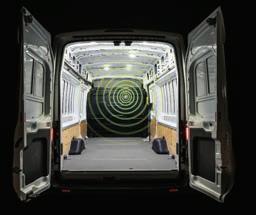
FOR FURTHER INFORMATION ON SPEED LIMITERS VISIT WWW.RDR.LINK/BAP101
DIGITAL SOLUTIONS
Described as a first of its kind venture in the commercial vehicle sector, Ford Pro provides fully integrated, digital-first solutions across software, charging, servicing and financing. The one-stop-shop solution can be utilised whether you’re operating diesel and petrol-powered vehicles, all-electric models, or even non-Ford vehicles.
GET MORE DETAILS AT: WWW.RDR.LINK/BAP103
PICK-UP
Isuzu UK has recently reached a significant milestone, with the registration of the 50,000th D-Max pickup in the UK. The latest generation achieves the maximum five-star safety rating in the tough new Euro NCAP test and features Advanced Driver Assist Systems (ADAS) fitted as standard. In 2022, the manufacturer also announced six new variants for the D-Max line-up and introduced the halo model, as well as the Arctic Trucks AT35.
GET MORE DETAILS AT: WWW.RDR.LINK/BAP104
SMART VAN ALARM
The ‘plug and play’ sensor on the ARMD GUARD Smart Van Alarm silently watches over your tools and, in the event of a break-in, the alarm triggers a phone call notification. This instant alert allows you to take immediate action by calling the police and catching them in the act while it locates and tracks your van, if it is stolen, with the inbuilt GPS.
OPENING NEW

Composite Doors? No problem. Well, there are a few rules….Quickslide’s Ade explains more.
Encourage your clients to spec good quality hardware and door furniture.

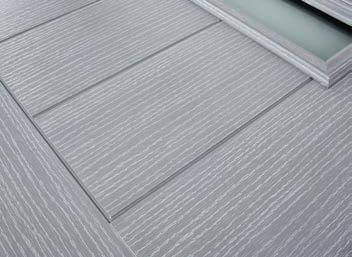
The front door of a house is the most important of the openings in a property – you may have other entrances into the house but the front door is the one that you invite your posh aunt Sally through when she comes for tea, your social climbing sister-in-law, or potential buyers when you decide to sell up. That simple rectangle has a disproportionate effect on the overall appearance of any property and is used by wily developers to add kerb appeal and distinguish homes on the 500 plus estates that they are building, with homeowners at the other end of the scale, realising that a brand new shiny composite door might be the best twelve hundred quid they could spend to give the place a very recognisable makeover.
But a door is a door is a door, right? Well, not quite. Just as with anything else in life, there’s the good, the bad and the ugly. And the old adage that you get what you pay for, works just as well when choosing doors too.
PVC pressed panel doors remain amazingly popular and still sell in their tens of thousands, not least because they are cheap as chips (or should be!) and fill a hole when (for example) budget is the ultimate criterion. But generally, when a decent finish, quality feel, high performance security and weatherproofing are required, a composite door is usually the ideal choice. But just like a book, you can’t judge it by its cover.
My preference is for doors with GRP skins on the outside, which most popularly can be made to look like grained timber, or increasingly with the smooth ‘engineered’ finish of aluminium. Colours are sprayed on in the factory and pretty much each and every hue can be applied. But whilst every colour of the rainbow might be available, it is best to choose lighter tones when the door is south and west facing, as the sun will soon take its toll and fade the colour, an effect that is less obvious with lighter tones. Steering your customers at this stage can save expensive call-outs later on.
And whilst on the subject of finishes and colours, it’s worth knowing that it’s almost impossible to get an exact match between the door and outer frame because they are produced from different materials

Woodgrain doors are produced using genuine timber doors as moulds.
Spot the difference: There will be slight differences in the finish between door and outer frame. This is Irish Oak Frame & Skin.
11TH in THE series DOORS
ONSITE
and coloured using different WITH processes.
I also prefer a solid foam core for the door, perhaps even with steel reinforcement, over the timber cores preferred by some producers. My experience is that water ingress is always a threat and when it happens, a timber core door will warp whilst PU foam remains resistant to moisture. Beneath the skins and containing the cores, inevitably is a timber subframe, although some more expensive composite doors with have an aluminium frame to keep everything together. Outer frames should complement the window frames of the property, even if the door is fitted separately.
Spending a bit more on the fixtures and fittings of a door will bring benefits to the homeowner. Not only will well-made fittings keep their looks, but they will also retain that oh-so-importantexpensive ‘feel’ for years. Front and rear entrance doors are operated many more times than any window in the house and the ‘touch’ of the door, how it opens and closes, locks into place, how the handle feels are all so very important. Spend a few quid more now and that feeling will go on throughout the life of the door.
And lastly, my old chestnut of carefully choosing your supplier rings true for resi-doors just as much as windows. After all, your future customers are likely to be drawn from your customers’ friends and neighbours. The choice of composite doors is quite enormous and therefore bewildering. A decent window and door supplier will already have done all of the legwork for you to offer the best that they believe is available.
A beautiful front entrance door can do as much to stylise a house as any other component.

FOR FURTHER INFORMATION ON QUICKSLIDE VISIT: WWW.RDR.LINK/BAP106
Why are you a builder? How did you get into the building game? Did you ever really think about it, or was it something you just drifted into? And – having become a builder – do you think you had particular characteristics that made you gravitate towards the job?
There is a photo online that has gone “viral” – as I believe the expression is – of a young man struggling to squeeze a sedan bed frame into the back seat of an ordinary saloon car. The picture – taken from above, from a nearby balcony – makes it obvious that his attempted task is impossible.
The accompanying caption states, “Here you can understand the importance of those wooden cube games in childhood”. This clearly refers to the toy we were all once presented with, consisting of a board with square, round, triangular etc holes cut in it, and a selection of shaped wooden blocks that we were supposed to try to fit through them.
Now, I don’t know about you, and I certainly don’t want to sound big-headed, but my honest recollection of that game, when I was a toddler, was that I took one look at it and decided not to waste my time. It was just so obvious. The square block goes through the square hole, the round block goes through the round hole – big deal. Please don’t make me demonstrate it to you.
So maybe that’s why I was destined to end up in the building game – because the way that materials and shapes and spaces fit together was always just so obvious to me.
I suspect this is the case for all us builders – things just look obvious to us which, amazingly, are not obvious to ordinary people. So you get called in to look at a house with a dampness problem, and before you’ve got out of the van you notice a green stain down one corner of the outside front wall.
As the client opens the front door, you say, “Looks like you’ve got a leaking gutter there, mate”.
“How do you know that?” he asks. [Thinks to self] Because it’s OBVIOUS!
I don’t know, maybe I wasn’t born with superior powers of observation –maybe I have just accumulated knowledge from my years working on buildings. But it doesn’t seem like that.
One other point. During the covid lockdown, I was having trouble finding a groundwork contractor to do a drive for me. I had never done a big drive myself before. So I asked my mate Damian if he thought he and I would be able to do it together.
“Jeff”, he said, “We are builders. We can do ANYTHING”.
And he was right. How hard can it be?
It’s those two characteristics – an appreciation of the blindingly obvious, and a can-do attitude, that make us the great builders that we are.
Jeff Howell
Here is a useful summary of all the adverts that appear in this issue of Professional Builder. Each is listed with its page number and a direct URL that will get you straight to the relevant online information
Alufold..................................................................................(page 38
www.rdr.link/BAP120
Buckbootz..........................................................................(page 55)
www.rdr.link/BAP121
Dakea..................................................................................(page 39)
www.rdr.link/BAP122
DEKS Industries Europe Ltd............................................(page 36)
www.rdr.link/BAP123
Eclisse UK Ltd......................................................................(page 11)
www.rdr.link/BAP124
estimator.com................................................................(back cover)
www.rdr.link/BAP125
Festool................................................................................(page 56)
www.rdr.link/BAP126
Helly Hansen UK Ltd..........................................................(page 6)
www.rdr.link/BAP127
Albatros..............................................................................(page 50)
www.rdr.link/BAP128
Made for Trade..................................................................(page 13)
www.rdr.link/BAP129
Made for Trade............................................................(pages 14,15)
www.rdr.link/BAP130
Makita (UK) Ltd..................................................................(page 18)
www.rdr.link/BAP131
Malmo/IDS..........................................................................(page 35)
www.rdr.link/BAP132
Marley Ltd............................................................................(page 41)
www.rdr.link/BAP133
Mirka (UK) Ltd....................................................................(page 31)
www.rdr.link/BAP134
Origin Doors Ltd................................................................(page 21)
www.rdr.link/BAP136
Origin Doors Ltd................................................................(page 23)
www.rdr.link/BAP137
Ox Group UK......................................................................(page 53)
www.rdr.link/BAP138
Pnu-Point Ltd......................................................................(page 59)
www.rdr.link/BAP139
Puma Safety......................................................................(page 50)
www.rdr.link/BAP140
Tuffx Processed Glass Ltd..................................................(page 4)
www.rdr.link/BAP141
Quickslide............................................................................(page 4)
www.rdr.link/BAP142
Rainclear Systems Ltd......................................................(page 20)
www.rdr.link/BAP143
Reliance Water Control....................(gatefold inside front cover)
www.rdr.link/BAP144
Rocket Door Frames..........................................................(page 46)
www.rdr.link/BAP145
Rocket Door Frames..........................................................(page 47)
www.rdr.link/BAP146
Rockwool UK Ltd..................................................................(page 8)
www.rdr.link/BAP147
Toolfair................................................................................(page 76)
www.rdr.link/BAP148
Webfleet Solutions UK......................................................(page 26)
www.rdr.link/BAP149
West Fraser Ltd..................................................................(page 29)
www.rdr.link/BAP150
Let’s talk about
YOUR HEART...
To understand AF it is important to understand a little about the heart. The heart is a muscle; its job is to pump blood around the body. It is made up of four chambers (two are at the top and are called the atria – the other two are called the ventricles). The pumping action of the heart (the heart beat) is controlled by electrical signals passing through the muscle. This allows blood to be pumped around the body as the muscle contracts and for the heart to refill with blood again when it relaxes.
In AF, the normal electrical signals that coordinate the heart to beat are abnormal and can start firing off at any time. This leads to the top chambers of the heart pumping out of sync with the rest of the heart muscle, and often it happens at a very fast rate. This is not good because it stops each heartbeat being as effective as a pump and disrupts the normally smooth flow of blood through the heart.
So how do you know if you might have AF? Some people will have no symptoms at all. If the heart rate is normal (60-100 beats per minute) there might be no symptoms of AF other than to feel an irregular pulse in the wrist or the neck. In other cases, AF causes the heart rate to be uncontrolled and very fast (over 140 beats per minute). If this is the case, people can feel unwell with palpitations, dizziness, shortness of breath and tiredness. Palpitations can be felt as a racing irregular heartbeat. They can come on very suddenly.
AF can happen to people in different ways. Sometimes the heart can flip in and out of an irregular rhythm and sometimes it is a permanent change. Treatment for AF will depend on the kind of AF you have and how fast the heart rate goes. Tablets can be given to control the heart rate, and in some cases to try and restore the heart to normal regular rhythm. In cases of AF that happens to younger

THIS MONTH GP ALICE FITZGIBBON COVERS A HEART CONDITION CALLED ATRIAL FIBRILLATION – OR AF FOR SHORT
patients, if there is a known onset of when it started, sometimes a procedure called cardioversion can be used to restore the normal electrical activity. This is when a shock is given to the heart muscle to restart the electrical signals. Not everybody is suitable for this procedure as its success will depend on what the cause of the AF is thought to be in the first place.
AF can happen for a number of reasons, but it is not fully understood. It is more common the older you get, and affects more men than women. It can be triggered in people by drinking too much alcohol, taking illicit drugs or smoking, having an infection like pneumonia, or if the thyroid gland is overactive. It is more likely to occur in people who have high blood pressure, heart disease or diabetes. Sometimes no cause is found.
It is important to see your GP for tests if you find you have an irregular heart beat or experience palpitations. These might include blood tests, an ECG (heart tracing to look at the rhythm of the heart), a 24 hour tape (a heart monitor worn for 24 hours to see if the heart rhythm changes), an echocardiogram (an ultrasound of the heart to look at the structure of the heart) or a Chest X-Ray.
AF is recognised as a condition that can make it more likely for blood clots to form in the heart and potentially be pumped to the brain causing a stroke. The likelihood of this happening can depend on factors such as age, gender and other medical conditions. If your doctor feels you are at moderate to high risk of having a stroke due to AF, you might be offered anticoagulation (blood thinning medication) to reduce this risk. There is also increased risk of heart attack and heart failure.
Please see your GP if you are experiencing palpitations. If you have sudden onset palpitations associated with feeling unwell or chest pain, it should be treated as an emergency and urgent assessment is required via A&E or a 999 call. Don’t ignore the signs.
FOR MORE ADVICE ON ATRIAL
FIBRILLATION FROM THE NHS VISIT WWW.RDR.LINK/BAP107
